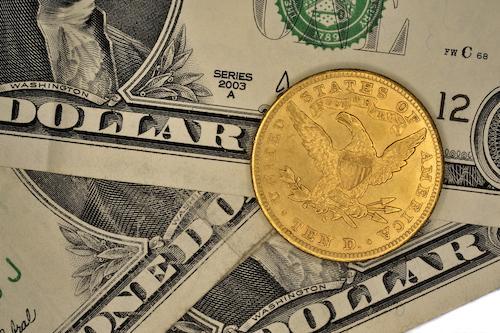
Gold and Equities – The Likely Effects of FOMC Proposals
U.S. equities do not yet seem to have taken on board the likely full effects of the Federal Reserve Bank (Fed)’s more aggressive policies announced after the recent FOMC meeting. Conversely, in particular, gold seems to have been somewhat more adversely affected by the assumed observations that interest rates will increase faster than previously predicted than it perhaps deserves.
To an extent, the effects on gold hark back to when interest rate raising proposals of a couple of years ago adversely affected the yellow metal’s price – and perhaps rightly so at the time. When this came about, high inflation levels had not raised their head and were not then seen as even a potential threat to the U.S. economy.
The Fed had, at the time, been struggling to get inflation even up to its preferred 2% level, let alone the 7% or higher being recorded today, which the latest Consumer Price Index (CPI) data would suggest.
Why should this make a difference? After all interest rate rises are interest rate rises, and indeed what knocked the gold price back a couple of years ago would do so even more strongly when they are predicted to rise at a much faster rate? Such is the logic of the less sophisticated investor.
But the big difference this time around is the far higher inflation rate which is driving the Fed’s more aggressive policy.
A couple of years ago, a rise in interest rates would have left the economy in a positive real interest rate scenario, which is generally seen as negative for a non-interest generating asset like gold. The safe investment solutions of government bonds and securities were seen as more positive wealth generators or protectors than non-interest-bearing assets like gold. Also, equities seemed to be on an ever-rising path, making them even more attractive as investments.
Now the position has changed quite drastically on both counts. Real interest rates are distinctly negative and look like staying so whatever the Fed does to try and raise them as it cannot raise rates fast enough to counter current inflation levels. Indeed inflation is still seen as being on the up, which makes the position even worse.
The Fed is also planning to bring its asset purchasing program to an end in a month’s time, and although this involves bond and mortgage security buying only, the perhaps unintended consequence is that it has seen liquidity flood into the equity markets too. With this stimulus falling away, coupled with higher borrowing rates, equity markets, which are already seen as ridiculously overstretched by many well-respected financial commentators and economists, are showing distinct signs of nervousness and weakness.
The combination of negative real interest rates coupled with a potential downturn in stock prices should be hugely beneficial for safe-haven assets like gold, even though they don’t generate income per se. We have already seen signs of a recovery in the gold price, which has rapidly regained the $1,800 plus level, after a fairly sharp fall, and we suspect will continue to run higher as investors switch out of what may be seen as more vulnerable equities. Equity indexes have been looking ever-increasingly weaker since the post-FOMC meeting announcements were made.
There have already been fears expressed that the Fed’s likely more ‘hawkish’ policies might drive the U.S. economy into recession. We had felt that the Fed might even hold back on at least a part of its proposed tightening program to try and avoid this consequence. But it looks like this is not to be with Fed chair Jerome Powell’s post-FOMC meeting press conference remarks suggesting no pullback on the latest more stringent proposals.
Not only did the vibes coming out of the meeting confirm that the asset-buying program would be brought to an end sooner rather than later, but the likely interest rate raising element would be enhanced over previous expectations too. Prior to the FOMC meeting, the general consensus had been that the Fed would likely implement three of four 25 basis point rate increases this year and again next.
After the meeting the expectation has now been raised to five or six rate increases this year and/or the thought that one, or even two, rate rises might be of a rather more demanding 50 basis points!
All this brings the threat of a Fed-induced recession somewhat closer. There is now a belief that the Powell Fed may be taking a leaf out of the Paul Volcker playbook (12th Chair of the Federal Reserve from 1979 to 1987) and drastically raising interest rates regardless of a recession likelihood – ‘for the longer term greater good of the U.S. economy.
However, where this differs from the Volcker era (September 5, 1927 – December 8, 2019) is that firstly inflation is not running nearly as high, at least not for now, and that the current Fed is starting to raise rates from a much lower base. The enormous U.S. debt position will also likely play a part in Fed decisions.
Borrowing is currently put at over $30 trillion and rising, and the costs of servicing such a high debt level become totally unsustainable with higher interest rates. In short, the Fed would be shooting itself in the financial foot if interest rates are to rise too far too fast.
The Fed has put its new concentration on an attempt to rein in inflation down to its claim that its previous principal target of bringing unemployment down to its maximum level has already been achieved. The latest nonfarm payroll data will serve to increase its confidence in this even though the overall unemployment rate still remains slightly higher than the Fed’s originally-stated target.
This writer does expect however that the Fed may well be forced before the end of the current year, by overall U.S. economic circumstances, to mitigate some of its more aggressive policies. Whatever it does, even if its interest raising plans remain as strong as some observers believe they will, this is unlikely to be sufficient to drive real rates into positive territory which has to remain bullish for the gold price. Meanwhile, equities will almost certainly trend lower as the economic stimulus that has been in place for so long, is diminished or eliminated altogether. If the Fed is, as we believe, forced to renege on some of its assumed policy proposals, this would be even more positive for the gold price going forwards.
Equities started the current week with falls in Asia and saw a little initial gold price strength in Asian and European trade. Silver too seemed to be beginning to pick up to nearer the $23 mark with the Gold:Silver ratio at least falling back to marginally below the 80 level. But the North American markets remain the key and things could change once they open, although we assume they will most likely follow the apparent initial global trends.






